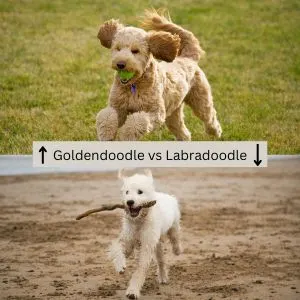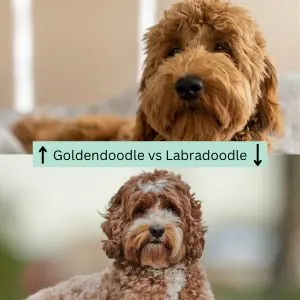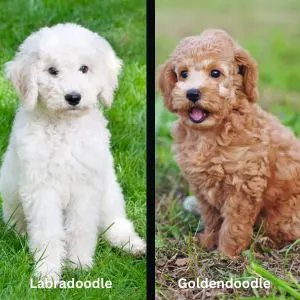Updated 01/04/2024: When it comes to choosing between two of the most popular designer dogs, the Goldendoodle and the Labradoodle, dog lovers often find themselves with a dilemma. Which one is best for them? While both breeds are known for their charming personalities, adorable looks and low-shedding qualities, there are some differences that might make one better suited for you. Join us as we take an extensive look at these two delightful breeds to understand what sets them apart and what they have in common. Whether you’re a prospective pet parent or just a dog enthusiast, this is your go-to guide for unraveling the unique characteristics of the Goldendoodle vs Labradoodle.
What are Goldendoodles and Labradoodles?
Before we look into the key differences, let’s get a brief overview of what these breeds are.
The Goldendoodle is a cross between a Golden Retriever and a Poodle, known for its intelligence, friendly temperament, and playful demeanor. On the other hand, the Labradoodle, a mix of a Labrador Retriever and a Poodle, stands out for its loyalty, energetic spirit, and sociability.
Both Goldendoodles and Labradoodles boast a hypoallergenic coat, a friendly nature and teddy bear charm, making them a great choice for families with allergies. While they share some similarities, the key differences between these two breeds lie in their temperament, physical characteristics, and even their grooming needs.

Goldendoodle vs Labradoodle: Can You Tell the Difference?
When looking at the two dogs in the above picture you might be thinking that they look a lot alike. You might even be surprised to find out that one of the doodles is a Goldendoodle and the other one is a Labradoodle.
Can you guess which one is which? Don’t worry, we’ll unveil the answer later in this post.
Despite their seemingly similar appearances, these two doodles have subtle but significant differences. These nuances could be the deciding factor in choosing the right doodle for you and your family. Stay tuned as we discover what sets them apart.
Goldendoodle Vs Labradoodle Breed Heritage
But before we look at the Goldendoodle vs Labradoodle we should first look at the parent breeds that make up these doodles. This will allow us to get a better understanding of where the dogs come from.
If you are looking at getting a doodle you probably already know that all doodles are part poodle, so let’s start there.

The Poodle
Although there is some disagreement about which country poodles were first developed, everyone agrees that the Poodle got its start as a waterfowl retriever. Their woolly, curly coat is perfect for keeping them warm while diving into cold water to retrieve a hunter’s catch. Plus, the curly coat is water resistant, allowing the water to run off the coat instead of soaking through to the dog’s body thus lowering their internal temperature.
Like all retriever type dogs, Poodles want to be with their people all the time. They are very loyal to their family. However, Standard Poodles can be standoffish to new people.
In addition to being a great family dog, the poodle is also known as the second most intelligent dog breed, right behind the border collie. This makes poodles easier to train, which is great for first time pet owners.
If that wasn’t enough good things about the poodle, the poodle is also considered to be hypoallergenic, making them an excellent choice for families with young kids or people with dog allergies. It’s no wonder that the poodle has been on the American Kennel Club (AKC) top ten lists since at least 2013. That is as far back as I could find the yearly lists.
The downside of Poodles is the coat maintenance. Since poodles have hair that constantly grows they need regular professional grooming. This includes daily combing and frequent hair trimming. Another distraction is that some people do not like the look of their tight curly coats.

Labrador Retriever
The Labra in Labradoodle stands for Labrador Retriever. The Labrador Retriever has been the most popular dog for 29 years in a row according to the American Kennel Club. Why you may ask? According to breeders they are extremely versatile, have a good temperament, are friendly, trainable, and athletic. I will also add that they are very family friendly and easy going.
Originally bred to support hunters in the fields and lakes, the Labrador wants to be by the side of their people all the time. They are a hard-working breed that likes to be busy. Although not considered to be as smart as the Poodle, the Labrador is easy to train and wants to please their people.
Labradors have a short double coat that repels water and insulates them from the cold. They also have webbed feet and an otter tail that makes them great swimmers. A Labrador’s short fur makes for easy maintenance. All they really need is a bath from time to time and an occasional brushing. Unlike the poodle the Labrador does not need regular grooming but they do shed when they go through a seasonal coat change. Brushing them regularly during this time will minimize the amount of hair laying around.
Labradors are also not considered hypoallergenic. This is why they were first bred with poodles in Australia to create a hypoallergenic guide dog.

Golden Retriever
Much like the Poodle and Labrador Retriever, the Golden Retriever was bred to retrieve a hunter’s catch. Originating in Scotland as a waterfowl retriever, the Golden was developed to have a thick under coat and a long water resistance outer coat to protect them from the damp Scottish weather.
The Golden has also been on the top ten list of dog breeds for many years now. Although bred to be a hunter’s working dog and companion, the Golden makes a great family dog. This is because of their relaxed, friendly nature. If you are looking for a guard dog do not look for a Golden. Most Golden Retrievers have never met a person they did not like.
Goldens are also not considered to be hypoallergenic. Their long thick fur sheds regularly, but is worse during the change of seasons. Goldens do need a bit more grooming then Labradors but not nearly as much as poodles. An occasional brushing and a bath will do.

Goldendoodle vs Labradoodle Comparison
Now that we looked at the individual breeds that go into the two most popular doodles, let’s look at what that mix means
Labradoodle vs Goldendoodle: Temperament
When looking at the individual breeds that create these two doodles, we see that they are all a type of retriever that likes the water. This means both the Labradoodle and the Goldendoodle will also like being around water. In addition they are all high-energy dogs that want to be around people, though Golden Retrievers are a bit less active than a Labrador. Both the Goldendoodle and Labradoodle are people pleasers. They want to make you happy so they are both easy to train.
Where they might differ is in how they interact with other people outside of the family. While both are considered to be friendly dogs, the Labradoodles might be a little less friendly to strangers and a little more protective of their families. On the other hand, a Goldendoodle wants to be everyone’s friend. But both dogs make great family dogs and companions.
Both poodle mixes can make great service dogs, but Goldendoodles might be better suited to work as therapy dogs, simply due to their very friendly nature.
Labradoodle vs Goldendoodle: Coat types
What type of fur your doodle will have depends on the generation of your Doodle. Doodle generations that have a higher percentage of Poodle in them will have a curlier, softer coat. Because of this it makes comparing a Goldendoodle to a Labradoodle a little difficult. For this reason we are only going to look at first generation doodles. So a doodle that is 50% Poodle and 50% retriever.
A first-generation labradoodle may have a wiry coat that is closer to a Labrador’s coat but with waves. A first generation Goldendoodle will have a soft, longer coat that may be curlier that the Labradoodles coat. These differences generally go away in later generations as the genes skew more towards poodles, but can still pop up from time to time.
To learn more about Doodle Generation Classifications and how it affects their coat type check out our post on Goldendoodle Generations.
Labradoodle vs Goldendoodle: Shedding
Many people are attracted to doodle mixes due to their promise of low-shed coats and hypoallergenic properties. But you may be wondering which mixed breed dog sheds less.
To answer this question I asked a group of Doodle Parents about shedding. Here is what I found.
- The majority of people with a Goldendoodle stated that their dog did not shed regardless of the generation
- Only a couple of Goldendoodle parents said their doodle shed.
- The majority of people with Labradoodles also stated that their dog did not shed.
- But there were more labradoodle parents that stated their Labradoodle did shed as compared to a Goldendoodle
- Also the Labradoodles that shed were mostly F1 Labradoodles.
- No one with an Australian Labradoodle stated that their doodle shed, but they were all multi-generation doodles.
So if a non-shedding dog is important to you, a Goldendoodle or a F1B Labradoodle might be the best choice. It seems that F1 Labradoodles have the greatest chance of shedding. But a lot depends on the breeder.
It also appears that the curlier the coat the less they shed. But as one Doodle mom pointed out, doodles with curly coats will mat more than one with a straight coat.
This information was derived from a small group of people who responded to the question. It does not guarantee that the doodle you chose will follow the same path.
To learn more about doodles check out our post Doodle Dog Guide – What You Need to know

Labradoodle vs Goldendoodle: Which one is Hypoallergenic
Since both the Labrador and the Golden are not considered hypoallergenic breeds both hybrid dogs can cause allergies.
In contrast, Poodles are often considered hypoallergenic, meaning they’re less likely to cause allergic reactions but this isn’t a guarantee. Remember, hypoallergenic simply means that it is “relatively unlikely to cause an allergic reaction“. It does not guarantee that it will not cause an allergic reaction.
For allergy sufferers the best bet is to go with a later generation doodle that has more Poodle in them than retriever. However everyone is different and so is every dog. If you have dog allergies you should spend time with the dog before you take them home. There are no guarantees that just because they are part poodle you will not be allergic.
Goldendoodle vs Labradoodle Size Comparison
The size of your doodle will have a lot to do with the size of the poodle bred with the retriever. Both the Golden Retriever and Labrador Retriever can be bred with the Standard Poodle, Moyen Poodle or Miniature Poodle. Dogs bred with a mini poodle are referred to as Mini Goldendoodles or Mini Labradoodles.
The chart below was created using information from breeders and actual data reported from Goldendoodle and Labradoodle owners. As you can see the Standard Goldendoodle can grow a little larger than the standard Labradoodle. While the mini Goldendoodle and Mini Labradoodle tend to be closer in size.
It is interesting to note that a full grown standard Goldendoodle and the standard Labradoodle tend to grow larger than the parent breeds.
Goldendoodle vs Labradoodle Size Comparison Chart
| Size | Goldendoodle Height | Goldendoodle Weight | Labradoodle Height | Labradoodle Weight |
|---|---|---|---|---|
| Standard | 21″ to 26″ | 50 to 120 Pounds | 21″ to 24″ | 50 to 100 Pounds |
| Medium | 15″ to 20″ | 30 to 50 Pounds | 15″ to 20″ | 30 to 50 Pounds |
| Mini | 12″ to 14″ | 15 to 30 Pounds | 12″ to 14″ | 15 to 30 Pounds |
Looking for a name for your large dog? Check out our list of Big Dog Names: 300+ Names From the Classic to the Unique
If you are looking for a mini doodle, check out our post on the Top 9 Mini Doodles.
Coat Color Comparison
Labradoodles
Labrador Retrievers come in either Black, Yellow or Chocolate. Poodles come in Black, Brown, white, Blue (Gray), Silver, Apricot, Sable, and Cream. Your doodle can come in any of these colors. Look at the parents to determine what color your doodle may be.
Goldendoodles
Golden Retrievers come in either dark red, light golden or cream color. Like the Labradoodle, the Goldendoodle can come in any of the regular Golden Retriever or Poodle colors (see above), but the light red or cream colors seem to be the most common Goldendoodle colors available.
Lifespan Comparison
The average Goldendoodle’s life expectancy is 10 to 15 years. As a comparison a Golden Retriever will live on average between 10 to 12 years and a Poodle will live between 12 to 15 years.
A Labradoodle can be expected to live on average between 12 to 15 years.
Cost comparison
The cost of a Labradoodle that has been fully health tested is around $3,000 to 3,500. A fully health tested Goldendoodle cost about the same. You can find both doodles for less, but if it is much less the parents will most likely have not had the proper health testing. Health testing helps to protect you from buying a doodle that will have future health care costs.
An alternative to buying a doodle is to adopt one from a rescue. To learn more about where you can adopt a Labradoodle, Goldendoodle or other types of doodles look here:
- Labradoodle Rescue: 14 Best Places to Find a Labradoodle
- The 9 Best Places to Find a Goldendoodle Rescue
- Bernedoodle Rescue: 15 Best Places to Find One
- Doodle Rescue: 12 Best Places to look for a Doodle
- Poodle Rescue: 9 Best Places to Look For One
- The Bernedoodle: 10 Things You Don’t Know About Them
Health Concerns
Note: Health Information and testing information was gathered from the Embrace Insurance website. I am not a veterinarian. Nor should anything in this post be considered legal or medical advice.
Labradoodle
Labradoodles can develop health conditions that are common to both the Labrador Retriever and Poodle. These include;
- Hip and elbow dysplasia
- Progressive retinal atrophy, an eye disease
- Patellar luxation
- Von Willebrand’s disease, a bleeding disorder.
Request the results of the genetic health testing that should be done on both parents to minimize the risk of buying a dog with future health issues.
Possible tests include:
- Hip and elbow certifications from the Orthopedic Foundation for Animals
- DNA test for progressive retinal atrophy
- Certification from the Canine Eye Registry Foundation that the eyes are healthy.
- A DNA test for von Willebrand’s disease
- For small or medium-size Labradoodles, the OFA patella (knee) clearance.
Goldendoodle
Goldendoodles can also develop health conditions that are common to the Golden Retriever and Poodle. Health concerns include:
- Hip dysplasia
- Sebaceous Adenitis, a skin disease
- Subvalvular Aortic Stenosis, a heart condition
- Addison’s disease
- Eye diseases such as progressive retinal atrophy, cataracts and glaucoma.
Make sure to ask the breeder for the results of health testing done on both the parents. This will minimize the risk of getting a puppy with future genetic health issues.
Possible tests include:
- Hip certifications from the Orthopedic Foundation for Animals,
- OFA heart clearance
- Certification from the Canine Eye Registry Foundation that the eyes are healthy.
- An OFA elbow clearance for standard Goldendoodles,
- An OFA knee clearance for small or medium-size Goldendoodles
- A DNA test for progressive retinal atrophy.
- For more information, see the Ribbon requirements set by the Goldendoodle Association of North America.
Only buy your doodle from a reputable breeder that puts the health of the parent dogs and future puppy over profit. To do this you should not buy a puppy from a breeder that cannot provide you with written, verifiable documentation that the parents were cleared of health problems that affect the breed. A “vet check” is not a substitute for genetic health testing.
Is the Goldendoodle the right dog for you? Join us to find out why the Goldendoodle is not for everyone.
Goldendoodle vs Labradoodle Final Thoughts
In many ways the Goldendoodle and labradoodle are a lot alike. Especially if you are getting a later generation doodle that has more Poodle in them. They are both great family dogs that are easy to train and want to be with their families. Neither doodle is suited to be left alone for long periods of time and may be prone to separation anxiety.
The main differences between the two are that the Goldendoodle may be a little more friendlier than the Labradoodle and a little less active. But both will need proper socialization as puppies, regular daily walks and exercise to keep them healthy and happy.
In the end both dogs make wonderful companions as long as they are socialized and properly trained. To learn more about how to train your new puppy check out our other posts on puppy training.
- Potty Training a Puppy: Made Easy
- Crate Training a Puppy – Made Easy
- How to Crate Train a Puppy: 10 Mistakes to Avoid
- Puppy Potty Training Mistakes
- How to Prevent Separation Anxiety in Puppies
- Here are 10 Secrets to Easy Puppy Training
If you are looking for more big dogs that don’t shed check out our post; 14 Big Dogs That Don’t Shed, But Still Have Fur
Which doodle is which?
Have you figured out which of the two doodles in the top picture is the Labradoodle and which is the Goldendoodle? As it turns out the one on the left is a Goldendoodle and the one on the right is a Labradoodle.


